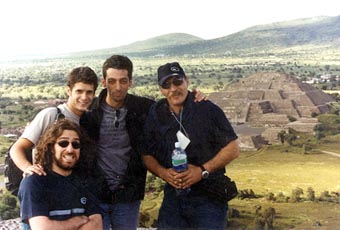Statement of research interests:
My primary area of research has been the characterization of phase transitions in finite non-extensive systems via numerical simulations. However, my research interests encompass a wide variety of problems from neuroscience to complex systems: I'm particularly keen on applying tools from statistical mechanics, computational physics and nonlinear dynamics to interdisciplinary topics.
During the last two decades a lot of interest has been paid to the study of small excited systems that fragment (break into pieces). In particular, the concept of phase transition has been extended to systems composed by only a few dozen particles [1,2]. In this sense the nuclear multifragmentation process has been the paradigm of such investigations.
I am currently investigating the fragmentation of small drops (~ 150 particles) by means of Molecular Dynamics simulations. One of our major achievements has been the understanding of the role of non-equilibrium in the fragmentation process and the appearance of negative values in the specific heat [3]. We have also related the thermodynamics with the dynamics of the system, and found that the Maximum Lyapunov Exponent is intimately related to the temperature and inter-particle collisions [4]. An important step in the understanding of the role of Coulomb interaction in fragmentation was given in [5]. By performing a systematic analysis of short and long-ranged systems we could find the connection between negative specific heats, long-range forces, density inhomogeneities and the role of spatial dimension [6].
In addition, we have focused on relative kinetic energy fluctuations, and found that its asymptotic values can be related to the number of decaying channels available to the system at fragmentation time [7].
Very recently we have started to explore the role of the isospin degree of freedom in fragmentation [8] and the inequivalence of statistical ensembles in non-extensive systems by means of an information theory approach [9].
[1] Phase Transformations in Nuclear Matter, J.A.Lopez and C.O.Dorso, World Scientific, Singapore (2000).
[2] Microcanonical Thermodynamics: Phase transitions in "small systems", D.H.Gross, World Scientific (2000).
[3] Nonequilibrium effects in fragmentation, A. Chernomoretz, M. Ison, S. Ortiz and C. O. Dorso, Physical Review C 64, 024606 (2001)
[4] Dynamical properties of constrained drops, M.Ison, P.Balenzuela, A.Bonasera & C.O.Dorso, Eur.Jour.Phys.A 14, 451 (2002)
[5] Role of Coulomb interaction in fragmentation, M.J.Ison and C.O.Dorso, Physical Review C 69, 027001 (2004)
[6] Caloric curves in two and three-dimensional generalized Lennard-Jones systems, M.J.Ison, A.Chernomoretz & C.O.Dorso, Physica A 341C, 389-400 (2004).
[7] Enhancement of kinetic energy fluctuations due to expansion, A.Chernomoretz, F.Gulminelli, M.J.Ison and C.O.Dorso, Physical Review C 69, 034610 (2004).
[8] Dynamical aspects of isoscaling, C.O.Dorso, C.R.Escudero, M.J.Ison and J.A.Lopez, submitted to Physical Review C (2005).arxiv: nucl-th/0504036
[9] M.J.Ison, F.Gulminelli & C.O.Dorso, in preparation.


